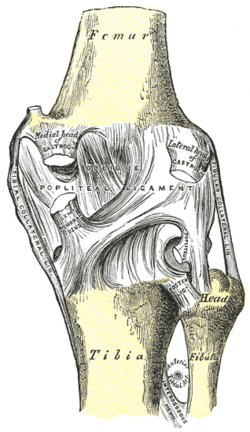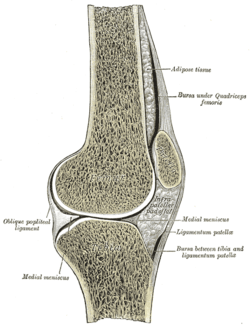Oblique popliteal ligament
The oblique popliteal ligament (posterior ligament) is a broad, flat, fibrous band, formed of fasciculi separated from one another by apertures for the passage of vessels and nerves.
| Oblique popliteal ligament | |
|---|---|
 Right knee-joint. Posterior view. (Oblique popliteal ligament visible at center.) | |
| Details | |
| From | lateral epicondyle of the femur, lateral condyle of femur |
| To | medial condyle of tibia |
| Identifiers | |
| Latin | ligamentum popliteum obliquum |
| TA | A03.6.08.013 |
| FMA | 44582 |
| Anatomical terminology | |
It is attached above to the upper margin of the intercondyloid fossa and posterior surface of the femur close to the articular margins of the condyles, and below to the posterior margin of the head of the tibia.
Superficial to the main part of the ligament is a strong fasciculus, derived from the tendon of the semimembranosus and passing from the back part of the medial condyle of the tibia obliquely upward and laterally to the back part of the lateral condyle of the femur.
The oblique popliteal ligament forms part of the floor of the popliteal fossa, and the popliteal artery rests upon it.
It is pierced by posterior division of the obturator nerve as well as the middle genicular nerve and vessels.
Additional images
 Sagittal section of right knee-joint.
Sagittal section of right knee-joint.
References
This article incorporates text in the public domain from page 340 of the 20th edition of Gray's Anatomy (1918)
External links
- Oblique_popliteal_ligament at the Duke University Health System's Orthopedics program
- lljoints at The Anatomy Lesson by Wesley Norman (Georgetown University) (postkneejointsuperfic)
- Anatomy photo:17:02-0400 at the SUNY Downstate Medical Center - "Major Joints of the Lower Extremity: Knee Joint"